“Ljubljana is just like Paris, except smaller. And without all the Parisians.”
So described Chuck to Lori of the capital of Slovenia. It was a joke. We love Parisians and everything Paris. We’d rather not get bombarded with “letter de colère”’s from the Parisian’s Antidefamation League full of snooty comments about our blog. We like to make our own snooty comments about our blog, thank you.
The comparison, however, stands. Ljubljana is a romantic little city, spotless and compact and happy. We used to think it exotic, but now it may figure into many of our future European travel plans. If you think this former Yugoslav city is too out of the way, keep this in mind: it’s less than a half-day away from Venice. Less if you avail yourselves of Europe’s cheap airlines.
Ljubljana is endlessly fun to learn to pronounce. Say “loob-lee-AHN-uh” three times fast and you’ll get it. The Ljubljanica River (similarly pronounced, but I’ll let you figure it out) takes a neat 90-degree turn at the base of a hill. The hill was a natural place to build a castle and the river’s bend a great spot for a town. The area has been settled since 2000 BC, making it one of the oldest towns in Europe. In Roman times it was known as Emona. In the middle ages the castle and town picked up the Slavic name it still bears.
And since 2011, the town has been designated a UNESCO World Heritage Site. It wasn’t our goal to visit as many World Heritage Sites this year as we have, it just worked out that way. Slovenia is a full member of the EU, within the Schengen visa zone, trading in Euros, and in the same time zone as the rest of Western Europe. The icing on the cake is that the locals love to speak English and their prices are reasonable. It really couldn’t be any easier to visit this town.
We spent four days in Ljubljana as we emerged from the Balkans further to the south and worked our way northwards to Central and Eastern Europe. We could have settled in for a few weeks, but those of you on vacations or holidays could see all seven of our sites easily in a day. But add an extra day to wind down and enjoy this charming “Little Paris”.

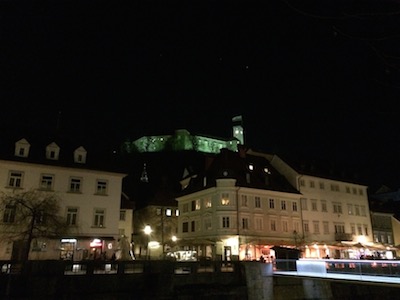
Ljubljana Castle – It’s an obvious choice for sites-to-see in Ljubljana. Coming here and not seeing it would be like going to Paris for the first time and not going up the Eiffel Tower. The castle provides sweeping views over the city and (on a nice day) all the way north to the Alps. You can’t miss the castle, as it looms over the city and is visible almost everywhere you go. You can walk up or you can pay a few Euros and ride a funicular. Different parts of the castle require different admission fees. If you love castles and want to see it all, go for the big ticket. Just riding the funicular or the free walk up gets you access to great views, the courtyard, and the chapel. We hear the buffet restaurant is good, but we enjoyed only a coffee.
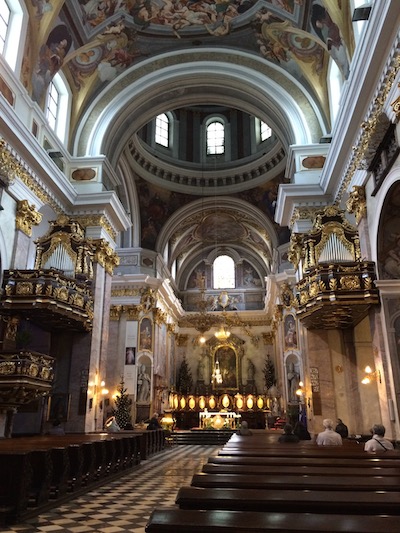
St. Nicholas Cathedral – This ornate, baroque Catholic cathedral is conveniently located on the main square street running parallel to the river and is in the shadow of the castle. The older, Romanesque parts of the church date from the 13th century, but it has been reworked several times over the centuries, today’s result being a curious but pleasant blend of styles. As a testament to the “relaxed communism” of Yugoslavia, the church was well maintained by the faithful throughout the 20th century. After the fall of communism, John Paul II paid a visit to this cathedral: look for the commemorative door.
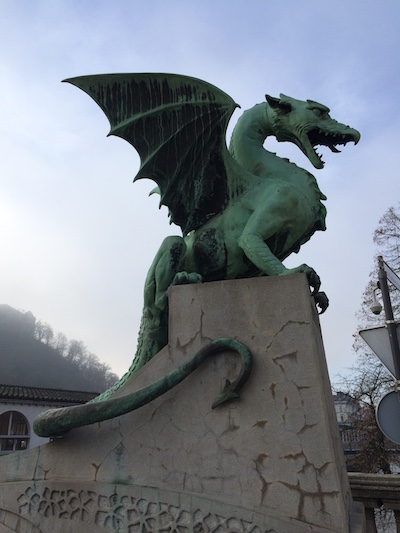
Bridges – The Triple Bridge, a grouping of three spans designed by idolized local architect Jože Plečnik (you have to love a city that idolizes an architect), is a famous landmark. Many tourists come to Ljubljana with the Triple Bridge as their numero uno site-to-see. Situated as it is just off the town’s main square and at the distinctive bend of the river, it is impossible to miss and an ideal spot to canoodle and tell your better half how splendid they look in the moonlight. But be sure also to see the Dragon Bridge and it’s wonderful statues of the symbol of the city; the Market Bridge and its grotesque statues; and the two lesser known bridges down from the Triple Bridge (one with a semi-see-through deck).
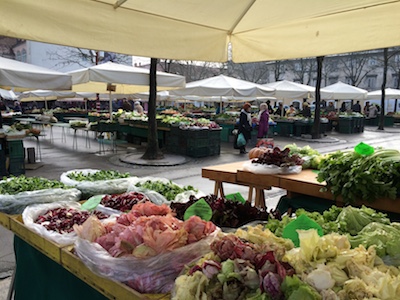
Market – We love markets, and Ljubljana’s is a nice one. At this daily market, located at the end of the street where the cathedral is found, you can pick up some fresh fruits and veggies as well as some emergency clothing items, should you have lost a glove or hat on one of the bridges. For meat and sausages and poultry, head back along the river and check out the shops on the riverside promenade. For souvenirs, look for the little shop on the market’s corner behind the cathedral (ask for a taste of the Slovenian blueberry liquor).
Prešeren Square – This square is the heart of Ljubljana. If you’ve been to the Triple Bridge already, it’s the square the bridge deposits you into on the north side of the river. You can tell you’re there by the presence of the statue of France Prešeren (Franz PREH-sure-in), the Francis Scott Key of Slovenia (he was a poet who wrote the lyrics to the Slovenian national anthem). During the holidays the square is also the sight for the city’s massive Christmas tree: when we were there, they were taking it down by cutting it into pieces and removing them with a crane.
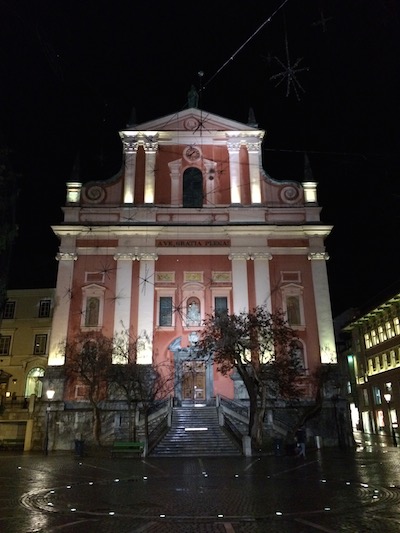
Franciscan Church of the Annunciation – This massive pink (ok, salmon) church defines the north end of Prešeren Square. It’s grander than the cathedral, though less ornate. If you are awed by Europe’s churches, go in. The massive wooden doors facing the square look closed, but they probably aren’t.

Coffee House – For a few centuries Ljubljana was under the rule (patronage) of the Habsburg Empire. Whatever was done in Vienna, it was emulated in Ljubljana. Much of the architecture of the city is modeled after that in Vienna, so it is as proper to say that Ljubljana is a “Little Vienna” as it is to say it’s a “Little Paris”. But one Viennese activity you can’t miss in Ljubljana is enjoying a coffee and people-watching. There are two spots we recommend. First, on the street to the right of the Franciscan Church, and just behind the church, you’ll find the Kavarna Union, the coffee shop of the beautiful Grand Hotel Union. After you enjoy a coffee and cake, wander around the hotel. For the other coffee experience, pick a café at random on the south (castle) side of the river and take a seat riverside.
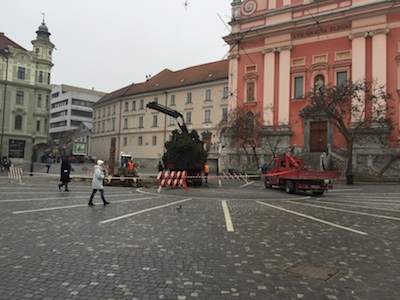
Removing the Christmas tree with chainsaws and crane






